Collectibles: Wall to Wall Art
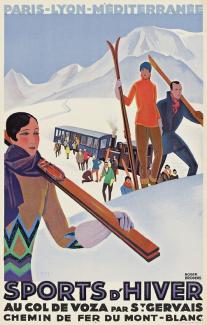
Swann Galleries annual vintage poster auction offers glamorous interpretations—and effective marketing—of skiing through the ages.
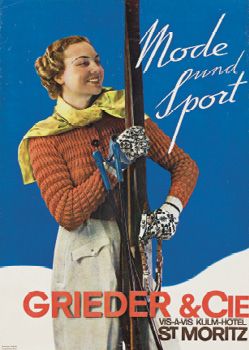
Above: French artist Roger Broders features vivid colors, hip fashion and an elite vibe in his Art Deco–styled work, which conveys skiing as “a sport for the young, the beautiful and the well-dressed.” Left: Unique for its era (1932), this poster by an unknown designer was sponsored by a fashionable St. Moritz ski shop (Grieder & Cie) and shows an early use of photography in poster art.
The annual vintage posters and graphic design auction at Manhattan’s Swann Galleries in February included 70 classic ski and winter posters. Spanning the turn of the 19th century through the late 1960s, this collection of fragile, and sometimes rare, artwork sparked intense bidding and likely a touch of nostalgia. Ranging from European resort designs to posters highlighting New England peaks and Western resorts, there was something for most collectors to get excited about.
“I have a lot of favorites in this auction for a lot of different reasons, as I always do,” says Nicholas Lowry, president of Swann Galleries and head of the poster department, as well as a frequent presenter on PBS’s Antiques Roadshow.
Lowry has an affinity for ski posters and a deep appreciation for the graphic artists who worked in this format. He loves the classics—the blue-chip posters that are the highest expression of the genre—but he’s equally enthralled by the rarities and the oddities, all of which were featured in this latest auction.
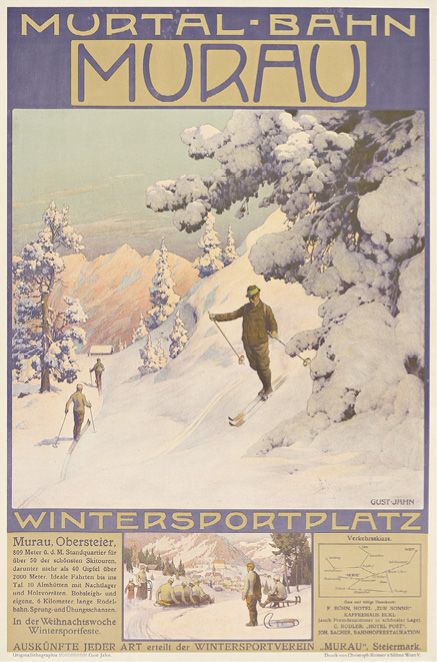
“I’m a huge fan of lot 186,” he says of a poster by Gustav Jahn, titled Murtal–Bahn Murau Wintersportplatz, from about 1910. “It’s a very early poster from the waning days of the Austro-Hungarian Empire, and stylistically it’s at the end of the Viennese Secession.”
Jahn was an Austrian painter, poster designer and avid mountaineer who studied at the Academy of Fine Arts Vienna. He designed posters for the Austrian State Railway, did illustrations of skiers and mountaineers for the Viennese sporting goods store Mizzi Langer and famously painted a dozen large-scale Alpine landscapes for the interior of the Austrian Government Building at the 1904 St. Louis World’s Fair.
The poster up for auction advertised both Murau, then a fledgling winter resort in the Austrian state of Styria, and the Murtalbahn, the narrow-gauge railway skiers would travel on from Vienna or Graz to get there. Commissioned in 1910 to promote skiing and bobsledding, it depicts three skiers in the larger upper panel and bobsledders in the lower panel. As Lowry points out, “The first thing you notice is how realistic it looks. Look at the snow on the tree branches. It really does look like a photograph, yet this is not a photograph. Jahn was a passionate climber and knew the mountains, as you can see in this poster.”
In 1919, at age 40, Jahn died in a climbing accident. This poster sold for $2,500, shy of its $3,000 top estimate. (The sale prices mentioned here include the buyer’s premium of 25 percent of the hammer price.)
Lowry also singles out Lot 200, the circa 1932 poster Grieder & Cie/St. Mortiz, by an unknown designer. Grieder & Cie, based in Zurich, opened this branch in 1927 across the street from the legendary Kulm Hotel. There, in 1864, hotelier Johannes Badrutt enticed four of his best English summer guests to return in winter. The invitation launched the British enthusiasm for winter-sport holidays.
This poster, from many decades later, depicts a fashionably dressed woman holding wooden skis, with the words “Mode und Sport” (Fashion and Sport) emblazoned above her against a background of white and blue. St. Moritz was then considered the most stylish resort in the Alps, so this poster and the skier’s singular outfit carried significant weight.
“I love this because it is a very early use of a photograph on a poster,” says Lowry. “It’s a colorized photo, which is even more unusual. The photograph isn’t an artist’s interpretation of what people were wearing. This is the actual photograph, so it’s the actual outfit. You have the gloves, the pants, the skis, the bindings, the pole straps and her sweater. Not to mention her hair. Everything is so of its time. But the fact that it’s a colorized photo circa 1932 is incredible to me.” Estimated at $700 to $1,000, the poster was a bargain at $438.
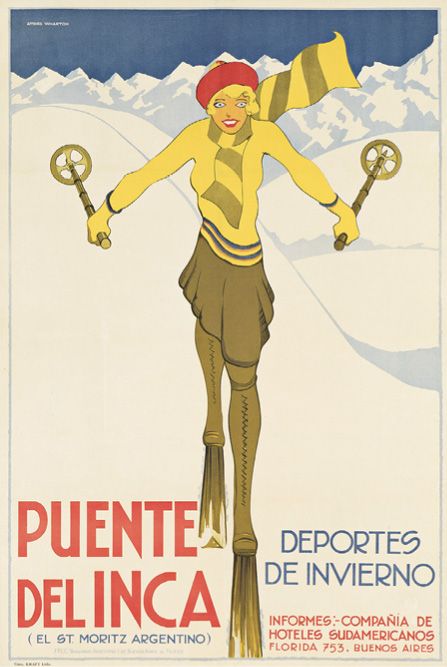
“You know I love the weird ones, and this is a weird one,” Lowry says of Lot 201. The poster for Puente del Inca, El St. Moritz Argentino (the St. Moritz of Argentina) is dated circa 1930 and shows a female skier in the Andes wearing a beret, sweater, skirt and leggings, her gaily striped scarf flapping in the wind with the words “Deportes de Invierno” (Winter Sports) next to her wooden skis.
“Puente del Inca is not a run-of-the-mill location,” notes Lowry. Situated in the country’s Mendoza province, it’s not far from Aconcagua and is known for its Incan ruins. The skiing was most likely at nearby Los Penitentes. “She’s wide-eyed and skiing in a skirt in a place that is relatively unknown,” he notes.
“From a design standpoint, the graphics are very eye-catching and the colors are amazing. It’s the perfect ski poster in many ways,” he adds. “It’s also in great shape, it’s unusual, and it’s rare. It’s only the second time we’ve seen it.” The poster sold for $4,500, based on an estimate of $3,000 to$4,000.
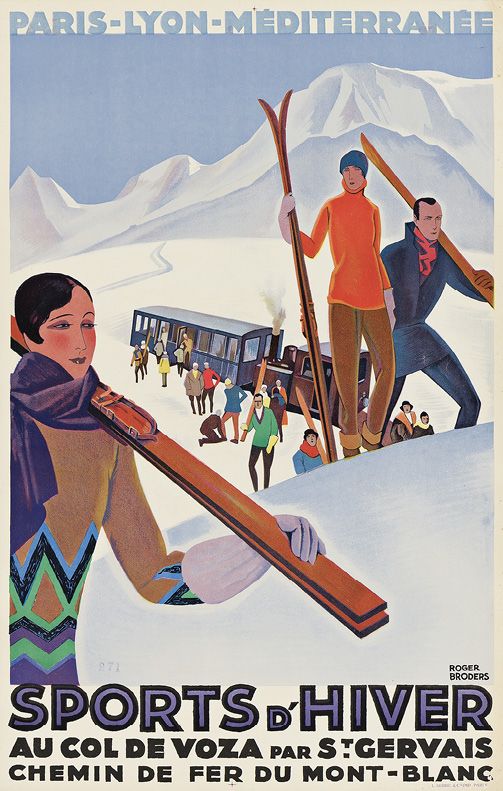
A well-known blue-chip poster with exceptional design, relative rarity and historical context commanded attention at the sale. Sports d’Hiver, by Roger Broders, exceeded its $9,000 top estimate to sell for $9,750. Broders was one of the masters of ski and travel posters in France, and his heyday was from the 1920s to the 1930s. His brilliantly colored artworks are carefully composed and invariably stylish, reflecting the era. This was one of 65 posters he designed for the Paris-Lyon-Méditerranée Railway during his career.
“It’s a classic Art Deco poster, looking like something out of an F. Scott Fitzgerald novel,” Lowry says. “Look at these beautiful people getting off that train. It’s sending out this message that you have to be a beautiful person to go skiing. It’s also saying that being out in the cold is good. It’s a sport for the young, the beautiful and the well-dressed.”
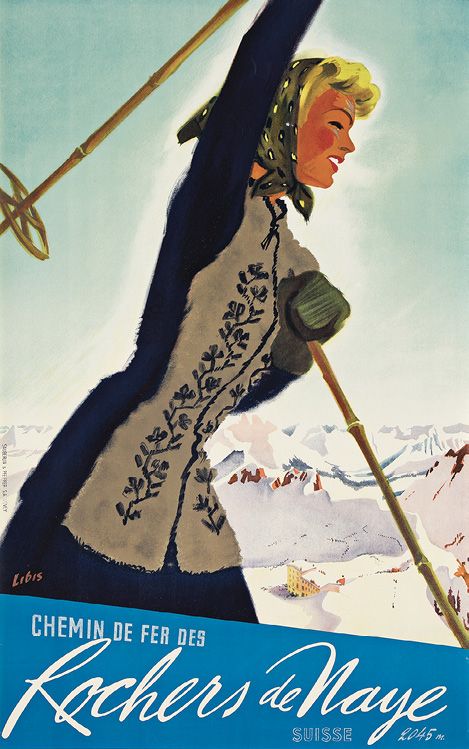
Two more modestly priced gems also caught Lowry’s eye. Rochers de Naye, a poster for a Swiss resort above Lake Geneva, came with an $800 to $1,000 estimate. Designed circa 1950 by an artist known as Libis, the pseudonym of Herbert Berthold Libiszewski, it features a female skier in fashionable clothing raising her ski poles against a snow-covered backdrop.
“It’s scarce, and this artist, Libis, has become very hot,” Lowry points out. “She’s wearing this incredible embroidered jacket, and there’s this great panorama. It’s very detailed, and it feels like you’re standing on top of the mountain looking down.”
Even so, it went for $625, far below its estimate and perhaps the best bargain of the sale. Lowry also singles out Mont-
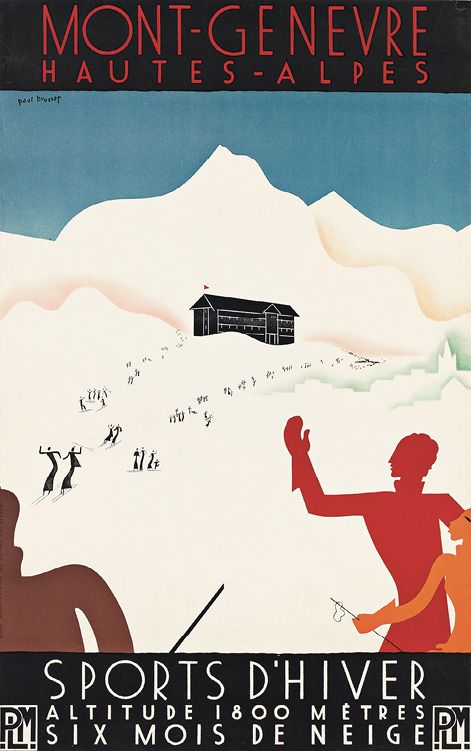
Genevre/Sports d’Hiver, circa 1930, by Paul Brusset. The resort, better known now as Montgenèvre, opened in 1907 and lays claim to being the oldest ski resort in France. It’s now part of the Milky Way resorts in the southern Alps. The poster promises “six months of snow.” Of the arresting design, Lowry says, “Abstract may not be the right word, but it’s not realistic, and yet it’s completely recognizable, from the cartoon-like silhouettes in the foreground to the black silhouettes on the mountains, including the hotel. The color scheme is just super fun.”
While European posters dominated this particular sale, there were also some fine examples from American ski resorts. Lou Hechenberger’s iconic New Hampshire poster (not shown) features a skier in a peaked visor cap skiing at a steep incline. The half-moon dip behind him is the lip of Tuckerman Ravine on Mount Washington, and the visor is a knowing nod to the peak’s glaring springtime sunshine. Rendered in blocks of color, it sold for $6,000, well above its high estimate of $4,000.
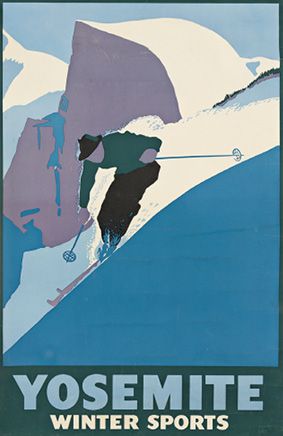
Yosemite Winter Sports is a terrifically energetic and stylized ski poster featuring a single skier in a Western-style felt fedora capably traversing a slope. The artist of this 1935 poster is unknown, but Lowry praises the obvious talent, noting that “various shades of purple are expertly used here, apart from the spray of powder coming from his skis.” At its sale price of $3,250, it fell within the estimated range of $3,000 to $4,000.
Lowry is rhapsodic about Lot 247, Sun Valley/Let’s Go/Union Pacific, circa 1940 (not shown). Created by artist Phil von Phul, better known for his work for the WPA, “it is one of the rarest Sun Valley posters,” Lowry says. “This is the third time we’ve had it since 2005. I love it, and I’ve always loved it. It’s rare, and it’s early for Sun Valley. The image is great.”
Showing three somewhat abstracted skiers flying through powder on a steep slope, “it just speaks to European sensibilities in an American poster,” Lowry adds. The poster sold for $2,500, shy of its $3,000 low estimate.
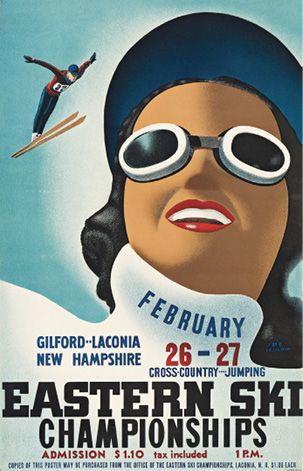
Then there was Joe Leibow’s Eastern Ski Championships/New Hampshire from 1937, a master class in perspective that shows a diminutive airborne ski jumper on the left while the face of a suntanned woman wearing goggles and bright-red lipstick on the right dominates the graphic. Her white sweater cleverly doubles as the snow-covered mountain the jumpers are on. The $4,750 price was just above the $4,000 low estimate.
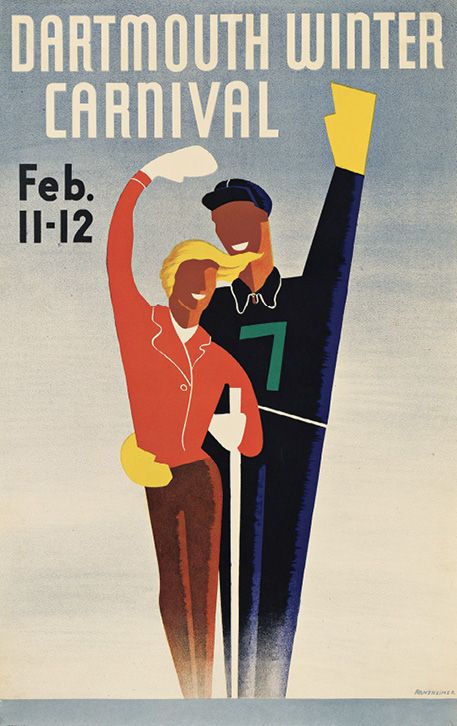
Jack Armsheimer created the 1938 Dartmouth Winter Carnival poster, showing a couple in fashionable ski sweaters, their arms raised high and their white teeth the only facial detail that conveys their joy. It went for $1,250, just over its low estimate of $1,200.
If there was a real American rarity at the auction, it was Ski Jumping/Milwaukee Racine/North Shore Line from 1928 (not shown). Artist Willard Frederick Elmes depicts a skier mid-flight, moving so fast that the tips of his skis have already disappeared off the poster’s left margin. It commanded $5,750, just below its $6,000 top estimate.
Only a relative handful of posters failed to sell. These included a famous poster for the Palace Hotel/St. Moritz from 1920 by Swiss artist Emil Cardinaux, which came with an estimate of $10,000 to $15,000 but did not meet its reserve price. Similarly, a well-known, circa 1935 Sascha Maurer poster for Flexible Flyer/Splitkein, a bird’s-eye view of a ski racer hurtling down a slope on his Splitkein skis, was estimated at $2,500 to $3,500 and did not sell. Nor did a Dartmouth Winter Carnival poster from 1937 by Edgar Hayes “Ted” Hunter Jr., estimated to be worth between $3,000 and $4,000.
Overall, the auction was highly successful, and the ski poster market remains strong despite fluctuations in the current U.S. economy. 
 This circa 1930 poster celebrates Puente del Inca as “the St. Moritz of Argentina,” with the message delivered by a stylish female skier traversing in a skirt and leggings, topped by a red beret.
This circa 1930 poster celebrates Puente del Inca as “the St. Moritz of Argentina,” with the message delivered by a stylish female skier traversing in a skirt and leggings, topped by a red beret.
Austrian painter Gustav Jahn, an avid Alpinist, strived to realistically portray the mountains. Commissioned by the Murau resort, along with the Murtal-Bahn railway to get you there, this early travel poster (1910) promotes both skiing and bobsledding.
Lowry is rhapsodic about Lot 247, Sun Valley/Let’s Go/Union Pacific,
circa 1940. Created by artist Phil von Phul, better known for his work for the WPA, “it is one of the rarest Sun
Valley posters,” Lowry says. “This is the third time we’ve had it since 2005. I love it, and I’ve always loved it.
 Noted as one of the best bargains of the auction, at $625, this 1950 poster by artist Libis features an enthusiastic skier in an intricately embroidered jacket saluting the
Noted as one of the best bargains of the auction, at $625, this 1950 poster by artist Libis features an enthusiastic skier in an intricately embroidered jacket saluting the
dramatic scenery of Swiss resort Rochers de Naye.
 Paul Brusset’s circa 1930 poster demands attention with its arresting use of silhouettes, unusual for its time. The poster pledges “six months of snow” for visitors to France's Mont-Genevre.
Paul Brusset’s circa 1930 poster demands attention with its arresting use of silhouettes, unusual for its time. The poster pledges “six months of snow” for visitors to France's Mont-Genevre.
 Above: Joe Leibow’s 1937 poster exhibits a dramatic use of perspective as a tiny jumper soars over the dominant graphic element of a spectator whose sweater cleverly conveys a snow-covered slope. Right: This emotive 1935 poster showcases an aggressive skier, sporting a fedora, taming Western terrain. It has become a popular vintage poster reprint.
Above: Joe Leibow’s 1937 poster exhibits a dramatic use of perspective as a tiny jumper soars over the dominant graphic element of a spectator whose sweater cleverly conveys a snow-covered slope. Right: This emotive 1935 poster showcases an aggressive skier, sporting a fedora, taming Western terrain. It has become a popular vintage poster reprint.
 Artist Jack Armsheimer created this poster for the 1938 Dartmouth Winter Carnival. With Art Deco-era posters consistently popular at the auction, this poster shows the bold and highly stylized graphic flourishes of that period.
Artist Jack Armsheimer created this poster for the 1938 Dartmouth Winter Carnival. With Art Deco-era posters consistently popular at the auction, this poster shows the bold and highly stylized graphic flourishes of that period.
